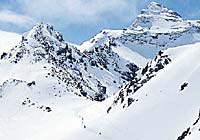Traveler: Les Trois Vallees...et Un

Armed with made-in-the-USA paranoia about a lurking patroller waiting to pull our lift tickets, our band of renegade Coloradans hesitated at the boundary rope and the sign warning, !Danger! Crevasses. We might have turned back, but we were following Sylvie Gacon, a second-generation instructor-guide from Méribel, to a back-of-beyond traverse. Sylvie, we reasoned, was the ultimate local. Sylvie grew up in these mountains. Sylvie surely knew where the crevasses were. Sylvie had a cell phone.
We were on the farthest fringes of Les Trois Vallées, by far the world’s largest ski area, set to explore a fourth valley that the trail map barely acknowledges. Our expedition had begun in Val Thorens, with a 7,500-foot base elevation, Europe’s highest ski resort. (The ski areas Val Thorens, Courchevel, and Méribel-Mottaret compose the Three Valleys.) From there we had ridden a daisy chain of lifts to a small, snowpacked notch more than 3,000 feet higher and had skied off the back toward the sign at which we now paused. We shuffled and slid half a mile or more, but there was no tedium to this long traverse. We gawked at a jaw-dropping procession of summits, ridges, and chutes¿pointes, arrêts, and couloirs in French¿as far as the eye could see. Only the derelict upper towers of a long-defunct lift poking out of a choppy sea of froth-white snow and sullen gray-brown rocks despoiled the view.
We shouldered our skis to climb perhaps 100 feet to the Col de Pierre Lory, a small pass between two spiky summits. Being French, Sylvie broke out cheese, bread, and butter cookies; sitting and eating gave us time to take in the scene. Behind us was a panorama of endless mountains. Below, the vast, virtually undeveloped valley that we were about to ski stretched between steep, rocky sidewalls rising hundreds of feet. The absence of trees, buildings, and humans gave us no sense of perspective. The strong overhead sun bleached the shadows from the snow surface. Was it smooth or lumpy? Soft or wind slab? No way to tell. Sylvie was a subtle guide, not a fountain of volunteered information. Unless we asked questions, she’d let us speculate as if we were exploring on our own¿the best type of guide, I’d say.
It was a good 20 minutes before anyone else appeared on the col, and by that time, we were ready to push off. Plunging into this snowy Shangri-la, we immediately dropped down the steep headwall above a glacier that we hadn’t realized was there. As we cruised down, our skis rose and dropped off little wind swales, which were like solid wavelets on a frozen sea. Sylvie steered us away from crevasse-prone spots, but otherwise, we had free reign on a playground that dwarfs any bowl in the western U.S. Another pitch signaled the foot of the glacier. We dropped through buttermilk-smooth snow to the valley floor. During the entire run, we saw just two other small groups in the distance; mostly, we were alone.
Time seemed to pass quickly and also to stand still. We continued to lose elevation, but the sense of solitude lasted until a chairlift drifted into view. It was the Rosael, climbing out of the valley to a nearby ridge. Skiers cruised down a groomed piste, hopped onto the chair, and rode back up, perhaps stopping for coffee at a hut on an enormous plateau called Plan Bouchet. A 12-passenger gondola from Orelle in the Maurienne Valley, which is practically in Italy, terminates there. Neither this two-year-old lift, rising over 4,500 vertical feet, nor the 2,000-vertical-foot Rosael chair is more than an afterthought in the context of the Three Valleys, which rounds its lift total off at 200 but doesn’t seem to actually count them all. If you ski across this grandiose domain from the farthest reaches of Courchevel to the Col de Pierre Lory, you’ll log something like 25 miles on skis and ride lifts of every sort, from swift surface skimmers to six-passenger chairs with double-conveyor loading platforms.
Val Thorrens wants to build more lifts on the Plan Bouchet, but permitting procedures are such that it could happen next winter, sometime in the next decade, or not at all. I won’t be sorry if it never happens. I’d miss the vast emptiness of the fourth valley, and I love being able to pass a !Danger! Crevasses sign without getting into trouble.
Les Trois ValléesFacilities: There are 200 (or so) lifts, 288 marked runs (28,000 groomed acres), and 50 mountain villages¿from large, modern resorts to tiny farming hamlets.
Vertical drop: The elevation is 10,500 feet at the top of Cime Caron, Val Thorens’ highest lift; the lowest lift starts in Brides-les-Bains (4,000 feet), and it is sometimes possible to ski all the way down.
Season: Late October to early May, plus summer glacier skiing.
Cost: Six-day adult lift pass, approximately $170.
Information: www.les3vallees.com; France on Call, 410-286-8310.